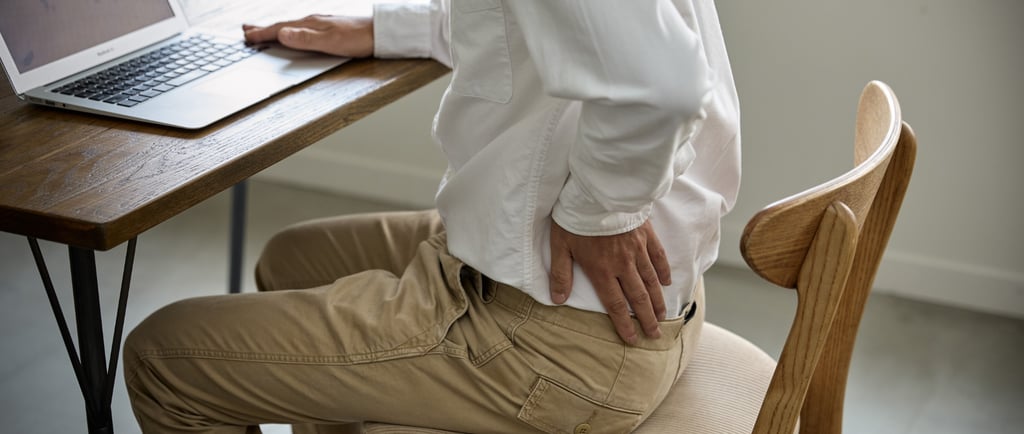Posture Police: Are You Sitting Your Way Into Pain?
In an increasingly sedentary world, where a significant portion of our days is spent seated – whether at a desk, commuting, or relaxing at home – the silent culprit behind a myriad of aches and pains often goes unnoticed: poor posture. It's as if a hidden "Posture Police" is constantly observing, and if you’re not careful, you might be sitting your way into pain without even realizing it.
10/16/20254 min read


In an increasingly sedentary world, where a significant portion of our days is spent seated – whether at a desk, commuting, or relaxing at home – the silent culprit behind a myriad of aches and pains often goes unnoticed: poor posture. It's as if a hidden "Posture Police" is constantly observing, and if you’re not careful, you might be sitting your way into pain without even realizing it.
From persistent neck stiffness to nagging lower back discomfort and even tension headaches, the cumulative effects of slouching, hunching, and improper alignment are profound and insidious. Ignoring these early warnings can lead to chronic musculoskeletal issues, reduced energy, and diminished overall well-being.
This article will shine a spotlight on "Posture Police: Are You Sitting Your Way into Pain?", unmasking the hidden dangers of poor posture, explaining its widespread impact, and, most importantly, providing practical insights to help you correct your alignment, alleviate discomfort, and reclaim a pain-free, energetic existence.
The Silent Saboteur: How Bad Posture Works
Understanding the silent saboteur: how bad posture works is the first step to combating its effects. Poor posture isn't just about looking slumped; it's about prolonged, unnatural positioning that places undue stress on your body's musculoskeletal system.
When you slouch, the natural curves of your spine are compromised, straining ligaments, compressing discs, and overstretching or shortening specific muscles. For example, hunching forward for hours tightens chest muscles while weakening upper back muscles, leading to rounded shoulders and neck pain.
Prolonged sitting with a rounded lower back compresses spinal discs and can pinch nerves. This constant imbalance forces certain muscle groups to work overtime to maintain even a semblance of stability, leading to fatigue, tension, and eventually chronic pain. The insidious nature of bad posture is that its effects accumulate slowly, often becoming noticeable only when significant discomfort or injury arises.


Your Body’s Red Flags: Common Pains Linked to Posture
Your body is remarkably good at signaling distress, and your body’s red flags: common pains linked to posture are often undeniable. The most common complaints include:
Neck and Shoulder Pain: Often stemming from a "forward head posture," where the head juts forward, placing immense strain on neck muscles and the upper back. This can lead to stiffness, muscle knots, and even radiating pain into the arms.
Lower Back Pain: Frequently caused by a slouched sitting posture that flattens the lumbar curve, compressing discs and putting pressure on spinal nerves. Prolonged standing with excessive arching can also be a culprit.
Headaches (Tension Headaches): Poor posture can lead to muscle tension in the neck and shoulders, which then radiates up into the head, triggering persistent tension headaches.
Wrist and Hand Pain (Carpal Tunnel-like Symptoms): Incorrect keyboard and mouse positioning, often a result of overall poor upper body posture, can strain the wrists and compress nerves, leading to numbness or tingling.
Hip and Knee Discomfort: Prolonged sitting can shorten hip flexors, leading to imbalances that affect gait and put extra stress on knees. Recognizing these specific pains as red flags is crucial for interrupting the cycle of postural pain.
The Ideal Alignment: What Good Posture Looks Like
To correct, you must first understand the ideal alignment: what good posture looks like. Whether sitting or standing, the goal is to maintain the spine's natural S-curve.
Standing: Imagine a string pulling you gently upwards from the crown of your head. Your ears, shoulders, hips, knees, and ankles should form a relatively straight line. Your shoulders should be relaxed and slightly back, not hunched forward. Your core muscles should be gently engaged.
Sitting: Your feet should be flat on the floor (or a footrest), with knees at about a 90-degree angle and aligned with your hips. Your back should be supported, maintaining its natural curve, possibly with a lumbar pillow. Your shoulders should be relaxed, elbows close to your body, and forearms parallel to the floor. Your computer monitor should be at arm's length, with the top of the screen at eye level. Achieving this ideal alignment distributes weight evenly, reduces strain on joints, and allows muscles to work efficiently without overcompensating.


Practical Fixes: Small Changes, Big Impact
Transforming your posture doesn't require an overhaul; it starts with practical fixes: small changes, big impact.
Regular Movement Breaks: Every 30-60 minutes, stand up, stretch, and walk around. Even 1-2 minutes can make a difference.
Ergonomic Adjustments: Invest in an ergonomic chair, external keyboard/mouse, or monitor stand. Adjust your current setup to fit your body as described above.
Conscious Awareness: Set reminders to check your posture throughout the day. Practice "posture checks" where you consciously realign your body.
Strengthening and Stretching: Incorporate exercises that strengthen core muscles (abdominals, back muscles) and stretch tight areas (chest openers, hip flexor stretches). Yoga and Pilates are excellent for this.
Foot Support: Ensure your feet are always supported, either on the floor or a footrest, to maintain proper lower body alignment. Implementing these small, consistent changes can gradually retrain your muscles and habits, paving the way for lasting relief.
Beyond Correction: Holistic Wellness for Posture Health
Finally, maintaining good posture goes beyond correction: holistic wellness for posture health is key. Regular therapeutic massages, especially deep tissue or traditional Thai massage, can effectively release chronic muscle tension, improve circulation, and re-educate muscles about proper alignment, with a focus on long-term stability.
Hydration is vital for disc health. Stress management techniques like meditation or deep breathing reduce overall muscle tension. Adequate sleep allows muscles and tissues to repair. Consider professional guidance from a physical therapist or chiropractor for persistent pain or significant postural imbalances.
By integrating these holistic elements into your lifestyle, you actively support your body's ability to maintain good posture, transforming it from a chore into an effortless habit and ensuring a future free from pain caused by poor alignment.
Conclusion
The "Posture Police" are always watching, and if you're not careful, you truly are sitting your way into pain. Poor posture is a silent saboteur, but by understanding its mechanisms and recognizing your body's red flags, you can take control.
Embracing ideal alignment, implementing practical ergonomic fixes, integrating regular movement breaks, and adopting a holistic wellness approach are all vital steps in correcting and maintaining good posture.
This isn't just about looking better; it's about alleviating pain, improving energy levels, and reclaiming your comfort and vitality in daily life. Invest in your posture, and you invest in a pain-free, more energetic future, ensuring your body thanks you.
Resources
Comprehensive information, practical tips, effective solutions, workplace health
Office Syndrome & Well-being
© 2024. All rights reserved. Designed by Pimclick - SEO Agency
Effective Exercises and Stretches for Relief
The Role of Workplace Wellness Programs
